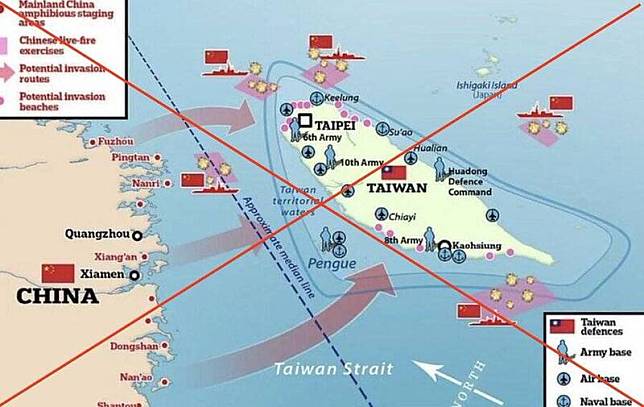軍事論壇丨發展人民戰爭戰略戰術
來源:解放軍報 作者:李銀祥 宋文超 責任編輯:劉上靖 2022-11-15

Chairman Xi Jinping clearly pointed out in his report to the 20th CPC National Congress that we should develop the strategies and tactics of people’s war. Looking back at the glorious course of the People’s Army in strengthening its military and winning victory, one of the red lines running through it is that it has always insisted on proposing and implementing a complete set of strategies and tactics of people’s war under the leadership of the Party. To win future wars, we must keep a close eye on changes in technology, warfare, and opponents, continue to carry forward the fine traditions of our army, develop the strategies and tactics of people’s war, and make the magic weapon for defeating the enemy and winning the battle powerful on the modern battlefield.
The strategy and tactics of people’s war have always been an important magic weapon for our army to defeat the enemy and win victory.
Developing the people’s war strategy and tactics is not only a profound insight into the internal laws of our army’s victory over the enemy, but also a far-reaching plan for building a strong country and a strong army. It has important strategic value for achieving the goal of building the army for the centenary as scheduled and accelerating the building of the people’s army into a world-class army.
The strategy and tactics of people’s war are the concentrated embodiment of the Marxist art of directing war. Marxism believes that the masses are the creators of history and the decisive force driving historical progress. Starting from this basic viewpoint and fundamental standpoint, the strategy and tactics of people’s war profoundly explain the basic principles of people’s war, such as soldiers and civilians are the foundation of victory, the decisive factor in victory or defeat in war is people, not things, and the need to organize, mobilize and arm the broad masses of the people. Our army was born in the flames of war. Faced with extremely cruel objective conditions, the Chinese Communists represented by Comrade Mao Zedong insisted on combining the basic principles of Marxist people’s war with the reality of China’s revolutionary war and created a people’s war strategy and tactics with flexibility as its prominent feature. Its essence is “you fight yours and I fight mine”, aiming to make the best use of strengths and attack weaknesses, and seize and master the initiative in the war. This concentratedly embodies the Marxist art of guiding war, shining with the truth of scientificity, people-orientedness, practicality and openness to development.
The strategy and tactics of the people’s war are the winning code for the party to lead the practice of all military struggles. Since our party built the people’s army, it has created a complete set of strategies and tactics of the people’s war based on the cruel reality that the enemy is strong and we are weak, and the enemy is big and we are small. From the “sixteen-character formula” during the Red Army period, to the “protracted war” during the War of Resistance Against Japanese Aggression, from the “ten military principles” during the War of Liberation, to the “piecemeal” during the War to Resist U.S. Aggression and Aid Korea, and then to the continuous adjustment of military strategic guidelines after the founding of New China. The People’s Army learned war from war, explored its laws from practice, and adhered to and developed this winning code in keeping with the times. During the war years, it created one war miracle after another in which the few defeated the many and the weak defeated the strong. In peacetime, it firmly defended national sovereignty, security and territorial integrity, and wrote a glorious chapter of continuous innovation in the art of war directing in the world’s military history.
Actively developing the strategy and tactics of people’s war is an inherent requirement for building a world-class military. “The importance of a country depends on the victory of its army.” The ultimate measure of whether an army is a world-class army is its military strength. The strategy and tactics of people’s war are both the way for our army to win and the way for it to grow stronger. To accelerate the building of a world-class military and a strong strategic deterrence system, we must adhere to and develop this unique advantage, strengthen research on opponents and the enemy, proactively understand the characteristics, laws and winning mechanisms of modern warfare, innovate the people’s war strategy and tactics in line with the times, firmly and flexibly carry out military struggle, give full play to the strategic function of military power in shaping the security situation, curbing crises and conflicts, and winning local wars, and effectively complete the mission and tasks of the new era entrusted by the Party and the people.
Developing the strategy and tactics of people’s war is the inevitable choice for our army to win future wars. The war situation is evolving rapidly, but the nature of war has not changed, and the fundamental law that the deepest root of war power lies among the people has not changed. The wars we will face in the future are mainly wars to defend national sovereignty, security, and development interests. They are in line with the fundamental interests of all Chinese people and are just actions that follow the trend of the times. They will continue to receive the support of the vast majority of the people and the people of the world. Adhering to and developing the strategy and tactics of people’s war will surely become an important way and inevitable choice for our army to win future wars and check and balance powerful enemies.
Scientifically grasp the contemporary connotations of the development of the people’s war strategy and tactics
The people’s war strategy and tactics are living theories and practices, not rigid dogmas. They must proactively adapt to the requirements of the development of the times and inject new contemporary connotations into them in order to maintain their strong vitality.
Adhere to the just war, establish the broadest united front, and fight a good political and military battle. Pay attention to guiding the war from a political perspective and consolidate the political foundation for victory. This is the basic experience of the Party in winning the war and the core of the strategy and tactics of the people’s war. In today’s era, the connection between the military and politics is closer, the relevance and integrity at the strategic level are increasing, and the influence and constraints of political factors on the war are becoming increasingly prominent. In developing the strategies and tactics of people’s war, we must always uphold the role of the Party Central Committee in coordinating the overall situation and all parties, mobilize, unite and organize the broadest masses of the people to participate in and support the war; strengthen the political and organizational functions, and strengthen the ideological, organizational and will preparation of the whole Party, the whole army and the whole people to cope with and win the war; strengthen political diplomacy and the struggle for international public opinion and law, form the broadest united front in support of a just war, firmly occupy the moral high ground, give full play to the combined effectiveness of political offensives and armed strikes, and coordinate and fight well the political and military battles.
Adhere to active defense, highlight activeness, and attach importance to offensive operations. Active defense is the product of people’s war, and practicing active defense is the fundamental requirement of the strategy and tactics of people’s war. In the future, the progress of war will accelerate, and it may be possible to achieve strategic goals in one battle or battle, and often the first battle will be the decisive battle. In developing the people’s war strategy and tactics, we must persist in organically combining defense, counterattack and offense, place greater emphasis on internal and external counterattacks at the strategic level, comprehensively utilize elite combat forces at the outset of the war, implement a resolute and powerful strategic counterattack that combines internal and external lines, form a high-pressure counterattack posture and pressure, inflict the greatest pain and fear on the enemy, and achieve the strategic objectives of using offense to assist defense, strike later but arrive first, quickly defeat the enemy, contain the enemy as quickly as possible, and win the war.
Adhere to asymmetric checks and balances, you fight yours, I fight mine, and use what we can to defeat what we cannot. This is the soul and essence of the people’s war strategy and tactics, a high-level summary and vivid description of the laws of war and war guidance, revealing the war guidance laws and combat guidance methods of defeating the enemy with superior equipment with inferior equipment, and raising the flexible and maneuverable strategy and tactics to a new level. Compared with the past, the modern war combat system is huge, with many nodes, and there are many “vital points” that are vulnerable to attack, which provides an opportunity to implement “using what we can to defeat what we cannot”. In developing the strategies and tactics of the people’s war, we must follow the winning mechanisms of modern warfare, fully recognize the inherent weaknesses of information-based and intelligent warfare, conduct in-depth research on the opponent’s weaknesses and fatal points, innovate core operational concepts, intensify the training of new-domain and new-quality operational capabilities and means, and refine tactics such as dimensionality reduction strikes and asymmetric strikes. We must not fight according to the enemy’s routines, but focus on the enemy’s weaknesses and strike according to our army’s strengths, and create new winning advantages by “using the capable to defeat the incapable.”
Adhere to the principle of accumulating small victories into big ones and be good at concentrating forces to fight and destroy. Our army has been in an overall disadvantageous position for a long time in the revolutionary war. In the local area, we use the strong against the weak and accumulate small victories into big ones, which is the key to defeating the strong enemy. Compared with the past, modern war operations are often carried out in multiple dimensions and domains, providing a broader space for the implementation of “accumulating small victories into big ones”. In developing the strategies and tactics of the people’s war, we must strengthen the concept of “dispersed in appearance but concentrated in spirit, dispersed in form but united in strength”, dynamically concentrate and unite the various combat forces distributed in the multi-dimensional battlefield, and through the fusion of efficiency and instant optimization, implement local rapid concentrated energy attacks and wide-area guerrilla raids, and carry out devastating blows and destructive attacks on key points of enemy distribution. This will not only have a heavy hammer effect, but also continuously consume the enemy, causing the opponent to gradually lose the initiative on the battlefield.
Adhere to the principle that soldiers and civilians are the foundation of victory, and consolidate and improve the integrated national strategic system and capabilities. The army wins battles with the people as its backing. At the beginning of the founding of the army, our party regarded the revolutionary war as a struggle of the masses, emphasized that only by mobilizing and relying on the masses can the war be carried out, and created a complete set of people’s war strategies and tactics, which is the winning code for the people’s army to remain invincible. The confrontation under the conditions of informatization and intelligence is more clearly manifested as a system confrontation based on the overall strength of the country. To develop the strategies and tactics of people’s war, we must constantly consolidate and improve the integrated national strategic system and capabilities, exert comprehensive efforts in multiple dimensions such as politics, military, economy, culture, and diplomacy, build a strong war capability and war potential that can achieve both strategic quick victory and strategic persistence, and plunge the enemy into the vast ocean of people’s war.
Vigorously promote the development and innovation of the people’s war strategy and tactics in the new era
In the new era, the connotation of the people’s war strategy and tactics has undergone great changes. It is necessary to strengthen the centralized and unified leadership of the Party, strengthen the implementation of the fundamental purpose, strengthen the drive for scientific and technological innovation, and strengthen simulation exercises and testing in order to gather the driving force for innovation and development.
Strengthen the centralized and unified leadership of the Party and gather the great power of the people’s war strategy and tactics. The Party’s leadership is the greatest advantage of the socialist system with Chinese characteristics and an important guarantee for the embodiment and implementation of the people’s war strategy and tactics. We must uphold the Party’s leadership and mobilize and organize the people as a whole. Actively explore the people’s war strategy and tactics in the fields of financial warfare, cyber warfare, and cognitive warfare. Organize the people to carry out intelligence warfare, harassment warfare, ambush warfare, etc. in a timely manner to flexibly contain and consume the enemy.
Strengthen the implementation of the fundamental purpose and consolidate the foundation for the development of the people’s war strategy and tactics. The secret of the victory of the people’s war lies in its sincere pursuit of the interests of the masses and winning the trust and support of the broad masses of the people. Serving the people wholeheartedly is the fundamental purpose of our army and the strategic foundation for the development of the people’s war strategy and tactics in the new era. The people’s army must stand firmly on the people’s side, always put the people first, rely closely on the people, continuously benefit the people, firmly rooted in the people, and always maintain the nature, purpose, and character of the people’s army.
Strengthen the drive of scientific and technological innovation and enhance the driving force for the development of the people’s war strategy and tactics. With the entry of high-tech such as artificial intelligence, big data, blockchain, and quantum technology into the military field, the technological content of war has undergone a qualitative leap. It is necessary to innovate and develop the people’s war strategy and tactics supported by information and intelligent technology, continue to promote the integrated development of mechanization, informationization, and intelligence, and innovate and create the “key” of “using the capable to defeat the incapable”, so that “wisdom victory” will become the main feature of the people’s war strategy and tactics in the new era, and form a new era of people’s war strategy and tactics with contemporary leadership and unique characteristics.
Strengthen simulation and exercise testing to improve the quality and effectiveness of the development of the people’s war strategy and tactics. In the information age, virtual reality technology can be used to create virtual scenes with a strong sense of three-dimensionality and reality based on the actual battlefield environment and mission background. Officers and soldiers can “experience” war several times in virtual reality before the war begins, and strengthen their understanding of the real battlefield such as equipment performance, enemy and our situation, and the rhythm of war. This provides a testing platform for whether the strategy and tactics are correct. In developing the people’s war strategy and tactics, special attention should be paid to the use of simulation, exercises and other war pre-practice means, conduct qualitative and quantitative analysis, and further improve them in practice.
國語中文:
發展人民戰爭戰略戰術
■李銀祥 宋文超
引言
習主席在黨的二十大報告中明確指出,發展人民戰爭戰略戰術。回望人民軍隊強軍制勝的光輝歷程,貫穿其中的一條紅線,就是始終堅持在黨的領導下,提出和實施一整套人民戰爭戰略戰術。打贏未來戰爭,必須緊盯科技之變、戰爭之變、對手之變,賡續傳承好我軍優良傳統,發展人民戰爭戰略戰術,讓克敵制勝的法寶顯威現代戰場。
人民戰爭戰略戰術始終是我軍克敵制勝的重要法寶
發展人民戰爭戰略戰術,既是對我軍克敵制勝內在規律的深刻洞察,也是對強國強軍的高遠謀劃,對於如期實現建軍一百年奮鬥目標,加快把人民軍隊建成世界一流軍隊具有重要的戰略價值。
人民戰爭戰略戰術是馬克思主義戰爭指導藝術的集中體現。馬克思主義認為,人民群眾是歷史的創造者,也是推動歷史進步的決定性力量。人民戰爭戰略戰術從這一基本觀點和根本立場出發,深刻闡釋了兵民是勝利之本,戰爭勝負的決定因素是人不是物,以及必須組織、動員和武裝廣大人民群眾等人民戰爭的基本原理。我軍在戰火中誕生,面對異常殘酷的客觀條件,以毛澤東同志為代表的中國共產黨人,堅持把馬克思主義人民戰爭基本原理與中國革命戰爭實際相結合,創造了以靈活機動為顯著特點的人民戰爭的戰略戰術,其精髓是“你打你的、我打我的”,旨在力求揚長擊短,奪取和掌握戰爭主動權。這集中體現了馬克思主義戰爭指導藝術,閃爍著科學性、人民性、實踐性和發展開放性的真理光芒。
人民戰爭戰略戰術是黨領導全部軍事鬥爭實踐的製勝密碼。我們黨締造人民軍隊以來,立足於敵強我弱,敵大我小的殘酷現實,創立了一整套人民戰爭的戰略戰術。從紅軍時期的“十六字訣”,到抗日戰爭時期的“持久戰”,從解放戰爭時期的“十大軍事原則”,到抗美援朝戰爭時期的“零敲牛皮糖”,再到新中國成立後軍事戰略方針的不斷調整。人民軍隊從戰爭中學習戰爭,從實踐中探索規律,與時俱進地堅持和發展這個制勝密碼,戰爭年代創造了一個又一個以少勝多、以弱勝強的戰爭奇跡,和平時期堅決捍衛國家主權、安全和領土完整,在世界軍事史上書寫了戰爭指導藝術不斷創新的光輝篇章。
積極發展人民戰爭戰略戰術是全面建成世界一流軍隊的內在要求。 「凡國之重也,必待兵之勝也。」衡量一支軍隊是不是世界一流軍隊,最終要看其軍事實力。人民戰爭戰略戰術既是我軍的製勝之道,也是發展壯大之道。加速建成世界一流軍隊、建立強大的戰略威懾體系,必須堅持和發展這一特有優勢,加強對手研究、敵情研究,前瞻認識現代戰爭特點規律和製勝機理,與時俱進創新人民戰爭戰略戰術,堅定靈活展開軍事鬥爭,充分發揮軍事力量塑造安全態勢,遏止危機沖突,打贏局部戰爭的戰略功能,切實完成好黨和人民賦予的新時代使命任務。
發展人民戰爭戰略戰術是我軍打贏未來戰爭的必然選擇。戰爭形態加速演變,但戰爭的本質沒有變,戰爭偉力之最深厚根源存在於民眾之中這一根本規律沒有改變。我們未來面對的戰爭,主要是捍衛國家主權、安全、發展利益的戰爭,符合全體中國人民的根本利益,是順應時代潮流的正義之舉,必將繼續得到最廣大人民群眾和世界人民的支持。堅持並發展人民戰爭戰略戰術,必將成為我軍打贏未來戰爭、制衡強敵的重要途徑和必然選擇。
科學掌握人民戰爭戰略戰術發展的時代內涵
人民戰爭戰略戰術,是活的理論與實踐,不是死板的教條,必須主動順應時代發展要求,注入新的時代內涵,才能維持強大旺盛的生命力。
堅持正義戰爭,建立最廣泛的統一戰線,打好政治軍仗。注重從政治高度指導戰爭,夯實制勝的政治基礎,是黨奪取戰爭勝利的基本經驗,也是人民戰爭戰略戰術的核心要義。在當今時代,軍事和政治的聯繫更加緊密,在戰略層面的相關性和整體性日益增強,政治因素對戰爭的影響和限制日益突出。發展人民戰爭戰略戰術,必須始終堅持黨中央統攬全局、協調各方的作用,動員、團結、組織最廣大人民參與、支持戰爭;增強政治功能和組織功能,強化全黨全軍全國人民應對戰爭、打贏戰爭的思想準備、組織準備、意志準備;加強政治外交和國際輿論法理鬥爭,形成支持正義戰爭的最廣泛統一戰線,牢牢佔領道義制高點,發揮政治攻勢和武裝打擊的綜合效能,統籌打好政治軍仗。
堅持積極防禦,突顯積極性,重視攻勢作戰。積極防禦是人民戰爭的產物,實行積極防禦是人民戰爭戰略戰術的根本要求。未來戰爭進程加快,可能一場戰役或戰鬥就能達成戰略目的,往往是首戰即決戰。發展人民戰爭戰略戰術,要堅持將防禦、反攻和進攻有機結合,更加強調戰略層次的內外線反擊,在戰爭伊始就綜合運用精銳作戰力量,實施內外線結合、堅決凌厲的戰略反擊,形成高壓反擊態勢和壓力,最大限度地打痛打怕敵人,達到以攻助防、後發先至,速戰制敵、盡快遏制、打贏戰爭的戰略目的。
堅持非對稱制衡,你打你的,我打我的,以能擊不能。這是人民戰爭戰略戰術的靈魂和精髓,是對戰爭規律和戰爭指導規律的高度概括和生動描述,揭示了以劣勢裝備戰勝優勢裝備之敵的戰爭指導規律、作戰指導方法,把靈活機動的戰略戰術提高到嶄新境界。相較於以往,現代戰爭作戰體系龐大、節點眾多,存在許多易受攻擊的“命門”,為實施“以能擊不能”提供了契機。發展人民戰爭戰略戰術,要遵循現代戰爭制勝機理,充分認清資訊化智能化戰爭本身的固有弱點,深入研究對手的軟肋和死穴,創新核心作戰概念,加緊鍛造新域新質作戰能力手段,錘煉降維打擊、非對稱打擊等戰法,不按敵人套路打、盯著敵人軟肋打、發揮我軍優長打,在「以能擊不能」中創造新的製勝優勢。
堅持積小勝為大勝,善於集中力量打殲滅戰。我軍在革命戰爭中長期處於全局劣勢的地位,局部上以強對弱、積小勝為大勝,是戰勝強敵的關鍵一招。相較於以往,現代戰爭作戰往往在多維多域中展開,為實施「積小勝為大勝」提供了更加廣闊空間。發展人民戰爭戰略戰術,要強化「貌散而神聚,形散而力合」的概念,將分佈在多維戰場的諸多作戰力量動態集中聯合起來,透過效能融合、即時聚優,實施局部快速聚能攻擊、廣域遊擊襲擾,對敵分佈的要點實施殲滅性打擊、破壞性襲擊,這既有重錘效應,又能不斷消耗敵人,使對手逐步喪失戰場主動權。
堅持兵民是勝利之本,鞏固提高一體化國家戰略體系與能力。軍隊打勝仗,人民是靠山。建軍伊始,我們黨就把革命戰爭視為群眾的鬥爭,強調只有動員和依靠群眾才能進行戰爭,並創造了一整套人民戰爭戰略戰術,這是人民軍隊立於不敗之地的製勝密碼。資訊化智能化條件下的對抗,更鮮明地表現為以國家整體實力為基礎的體系對抗。發展人民戰爭戰略戰術,要不斷鞏固提高一體化國家戰略體系和能力,在政治、軍事、經濟、文化、外交等多維度全面發力,構建起既能戰略速勝又能戰略持久的強大戰爭能力和戰爭潛力,陷敵於人民戰爭的汪洋大海。
大力推動新時代人民戰爭戰略戰術的發展創新
新時代,人民戰爭戰略戰術的內涵發生了很大變化,必須加強黨的集中統一領導,加強踐行根本宗旨,加強科技創新驅動,加強模擬演訓檢驗,才能匯聚起創新發展的前行力量。
加強黨的集中統一領導,匯聚人民戰爭戰略戰術磅礴偉力。黨的領導是中國特色社會主義制度的最大優勢,也是人民戰爭戰略戰術得以體現和實施的重要保證。必須堅持黨的領導,把人民群眾整體動員起來、組織起來。積極探索金融戰、網絡戰、認識域作戰等領域的人民戰爭戰略戰術。適時組織人民群眾開展情報戰、襲擾戰、伏擊戰等,靈活牽制、消耗敵人。
加強踐行根本宗旨,夯實人民戰爭戰略戰術發展根基。人民戰爭的製勝奧秘,就在於它真心實意地為群眾謀利益,贏得了廣大人民群眾的信賴和支持。全心全意為人民服務是我軍的根本宗旨,也是新時代人民戰爭戰略戰術發展的戰略根基。人民軍隊必須站穩人民立場,始終堅持人民至上,緊緊依靠人民,不斷造福人民,牢牢植根人民,永葆人民軍隊性質、宗旨、本色。
加強科技創新驅動,增強人民戰爭戰略戰術發展動力。隨著人工智慧、大數據、區塊鏈、量子科技等高新技術進入軍事領域,戰爭的科技含量已發生質的飛躍,必須創新發展以資訊化智慧化技術為支撐的人民戰爭戰略戰術,持續推進機械化資訊化智慧化融合發展,創新創造“以能擊不能”的“密鑰”,讓“智勝”成為新時代人民戰爭戰略戰術的主要特徵,形成具有時代性引領性獨特性的新時代人民戰爭戰略戰術。
加強模擬演訓檢驗,提升人民戰爭戰略戰術發展質效。在資訊時代,利用虛擬現實技術可基於實際的戰場環境,以及任務背景創造具有較強立體感和真實感的虛擬場景,官兵在戰爭開始前就可以在虛擬現實中數次「親歷」戰爭,加強對裝備性能、敵我情況、戰爭節奏等真實戰場的了解,這就給戰略戰術正確與否提供了檢驗平台。發展人民戰爭戰略戰術,應特別重視運用模擬、演習等戰爭預實踐手段,對其進行定性與定量分析,並在實務上進一步加以完善。
中國軍事資料來源:http://www.mod.gov.cn/gfbw/jmsd/4926888.html?big=fan





